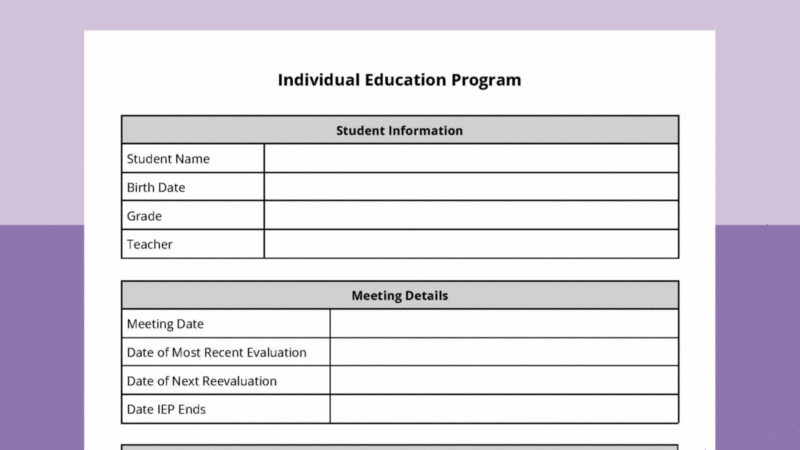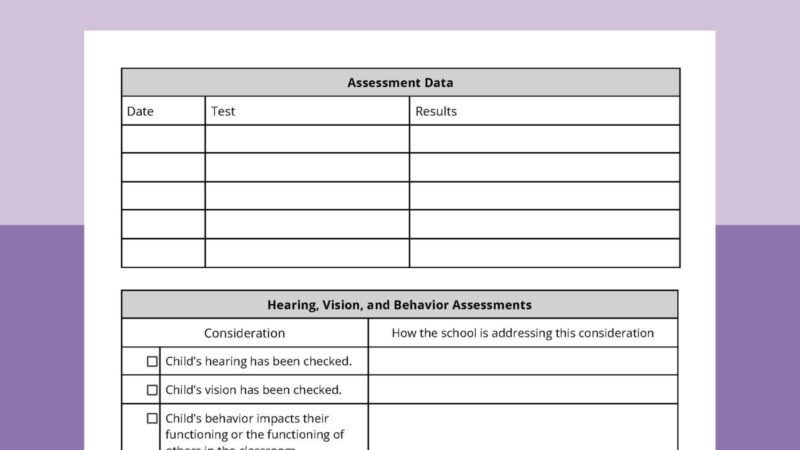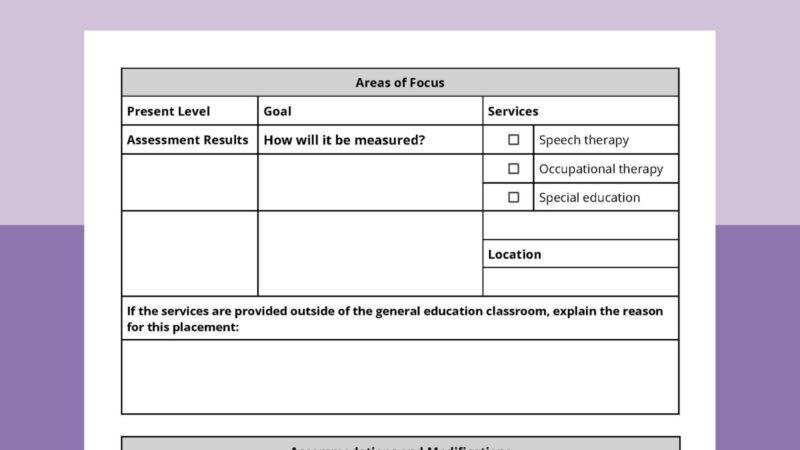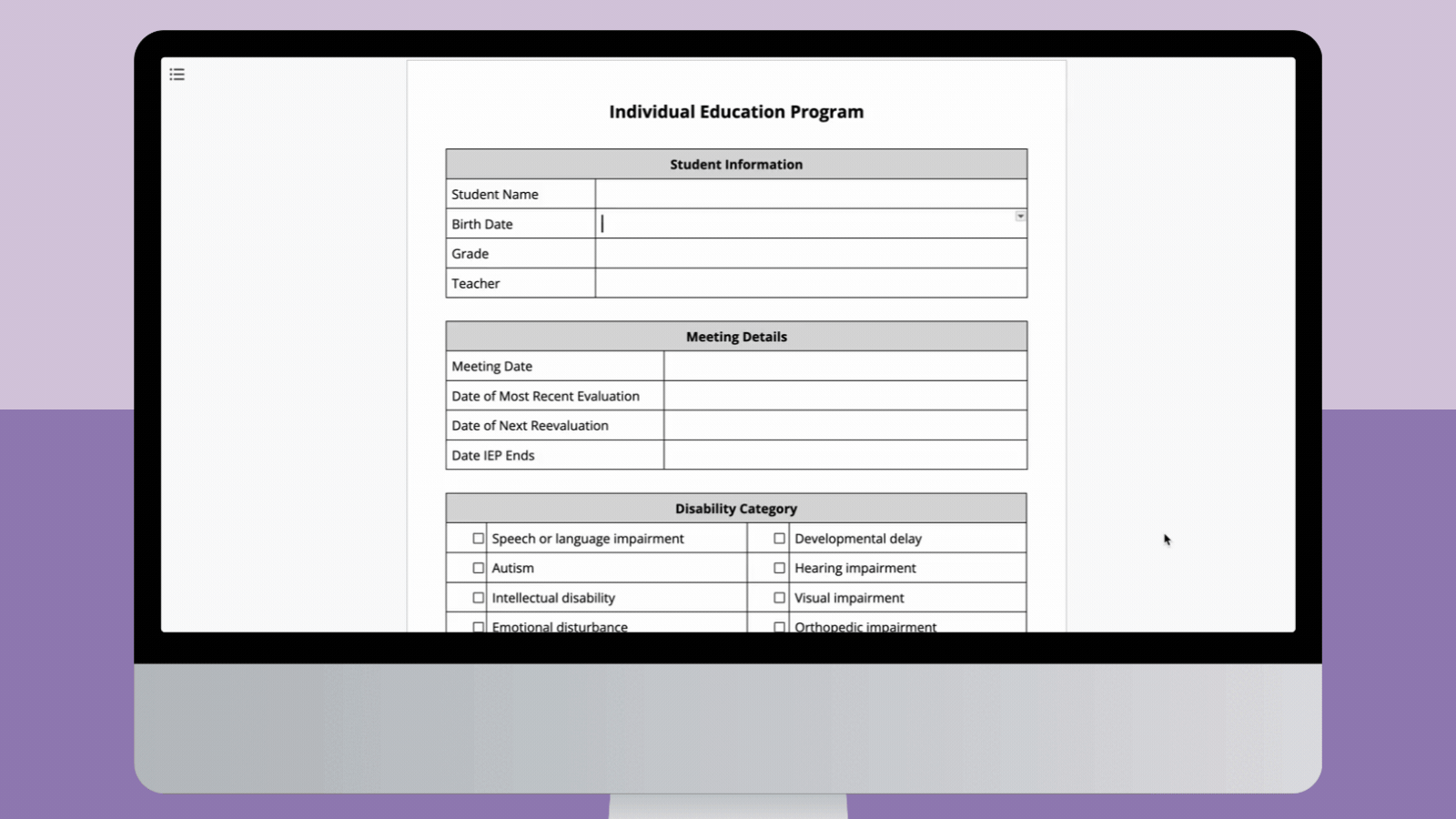An individualized education program (IEP) is a big document! It helps to have a guide to make sure you’re including all the necessary information. Grab our free IEP Google Docs template to help walk you through the process of writing the document by filling out the form on this landing page. Then read on to learn more about how to use it.
An IEP lays out an individual plan for a child’s education. IEPs are written for students who have disabilities that impact their ability to access the general education curriculum. This means anything from a child who is blind and requires instruction in braille to a child who has ADHD and requires small-group instruction in math. The information in each IEP will be unique to the student, but every IEP contains some core components.
What sections are included in the IEP template?

By law, an IEP has to include certain information. The purpose of an IEP is to set goals for the child’s education, and to explain the special education and related services the child will receive. Services include specially designed instruction (or instruction from a special education teacher either in a separate classroom or in the general classroom) and therapy like speech or occupational therapy. So, the IEP outlines what the child will experience across a school day and how the team will know the child is progressing (their goals).
When an IEP team sits down to develop an IEP, they will consider all aspects, even if one does not apply to the child. So, a transition plan will be included in the IEP, even if the only text is that the child does not require a transition plan at this time. That’s because each IEP must include information that’s required by IDEA, the Individuals With Disabilities Education Act.
Our IEP template includes all the things that need to be included to provide a well-thought-out, complete IEP, including the following:
Student Profile
An overview about the student, their strengths, and parents’ concerns.
Assessment Information

An overview of the assessments that were administered to the student. These may include psychological assessments, academic assessments, information from doctors’ evaluations, school-level grades and tests, and vision and hearing screening information.
Statement of Eligibility
Each IEP must have a statement explaining why the student is eligible for special education services. This statement outlines why the student requires support to access the general education curriculum.
Areas of Support
The team will use the assessment data to identify areas of support that the student needs. For example, if a student with a learning disability has an academic deficit in reading but not math, the IEP will provide services in reading but not math.
Present Levels of Performance
Present Levels of Performance are a statement of the child’s present levels of academic achievement and functional performance, or PLOP. This section explains what the child is able to do for each area of support and helps develop goals that are appropriate.
Goals

Goals must be measurable and achievable within a school year. The goals can be academic or functional. Each goal must be measurable and include a description of how it will be measured and when progress reports will be provided to parents. Goals may also have objectives, depending on the student’s disability and level of the goal. For example, students who are provided with services in a full-day special education classroom will have objectives that help monitor their IEP goal progress because more of their education is provided in the special education setting.
Special Education and Related Services
This is a description of which special education and related services will be provided, when, and where. Each description must provide the frequency, location, and duration of services. This includes an explanation of how much time the child will spend outside of general education, if any.
Accommodations and Modifications

This is an overview of the accommodations and modifications that will be provided, and specifics about how teachers will provide them. This includes information like the training needed for teachers. There is also space for testing accommodations.
If the child is not participating in the state tests or is taking alternate assessments, the IEP will include a statement about why they cannot participate in the regular assessment.
Transition Services
Transition services are outlined when a child is making a transition in their education. This could be from early childhood services to elementary school, middle to high school, or high school to life after school. When a child is transitioning out of school, starting when they are 16, an IEP must include measurable post-secondary goals and transition services needed to assist the child in reaching their goals.
Why use an IEP template?
Using a template for planning an IEP ensures that each IEP includes all the necessary information that’s required by law. It also ensures teachers have all the information that they need to help each student progress in their education.
Additional resources to use with your IEP template
Here are some more resources to use with the IEP template to write a great IEP every time:
Get your free IEP template printable!

To get your free Google Docs IEP template, just fill out the simple form on this page for instant access.

